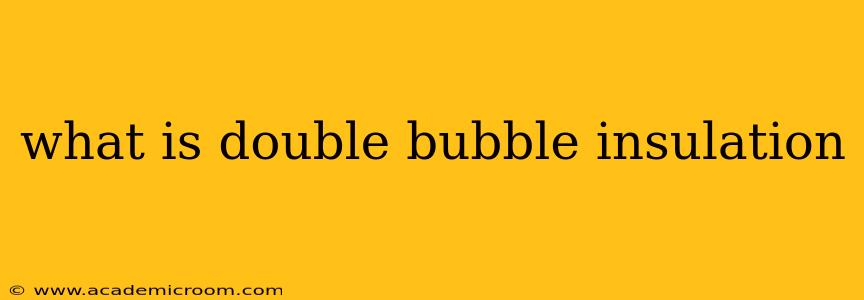Double bubble insulation, also known as reflective insulation, is a type of thermal insulation that uses multiple layers of thin, usually plastic, film separated by air pockets to reduce heat transfer. Think of it like a really sophisticated, multi-layered bubble wrap. But unlike standard bubble wrap, double bubble insulation is specifically designed for optimal thermal performance and often includes additional features to boost its effectiveness. This guide delves into the specifics of this unique insulation material.
How Does Double Bubble Insulation Work?
Double bubble insulation's effectiveness stems from its unique structure. The multiple layers of film create several air pockets, which act as insulators. Air itself is a poor conductor of heat, meaning it doesn't readily transfer heat. The bubbles trap the air, significantly reducing the amount of heat that can pass through the material. Additionally, the reflective properties of the film surfaces further minimize heat transfer through radiation. The reflective surfaces reflect radiant heat back to its source, keeping it from penetrating the insulation.
What are the Advantages of Double Bubble Insulation?
Double bubble insulation boasts several compelling advantages:
-
Lightweight and Easy to Install: Its lightweight nature simplifies installation, making it a good choice for DIY projects. It's flexible and easy to cut and shape to fit various spaces.
-
Cost-Effective: Compared to some other insulation types, double bubble insulation is often more affordable.
-
High R-Value for its Thickness: Although the R-value (a measure of thermal resistance) varies depending on the specific product and number of layers, double bubble insulation provides a relatively high R-value for its thin profile. This is particularly beneficial in situations where space is limited.
-
Moisture Resistant: The sealed air pockets help to resist moisture penetration, protecting the underlying structure from water damage.
What are the Disadvantages of Double Bubble Insulation?
While double bubble insulation offers several benefits, it's crucial to acknowledge its drawbacks:
-
Lower R-Value Compared to Traditional Insulation: While its R-value is decent for its thickness, it generally doesn't match the R-value of thicker traditional insulation materials like fiberglass or cellulose.
-
Susceptible to Punctures: The thin film layers can be easily punctured, compromising the insulation's effectiveness. Careful handling during installation is essential.
-
Limited Applicability: It's best suited for applications where a thin, lightweight insulation layer is needed, such as in roofing underlayment, radiant barrier applications, or protecting pipes. It's less suitable for applications requiring high R-values or significant structural support.
-
UV Degradation: Prolonged exposure to direct sunlight can degrade the material over time, reducing its effectiveness.
Is Double Bubble Insulation Suitable for My Project?
The suitability of double bubble insulation depends entirely on the specific application. Consider these factors:
-
Required R-value: Determine the necessary R-value for your climate and building code requirements.
-
Available Space: If space is limited, double bubble insulation’s thin profile might be advantageous.
-
Budget: Its relatively lower cost compared to other options makes it attractive for budget-conscious projects.
-
Environmental Concerns: Some manufacturers offer recycled or recyclable double bubble insulation, which can be a plus for environmentally conscious builders.
What are the Different Types of Double Bubble Insulation?
Various types of double bubble insulation exist, differing in thickness, material composition, and reflective properties. The specific features influence the insulation's R-value and overall performance. Always check the manufacturer's specifications before selecting a product.
How is Double Bubble Insulation Installed?
Installation techniques vary depending on the specific application. Generally, it involves cutting the material to the required size, securing it in place with tape or fasteners, and ensuring proper air sealing to maximize its thermal performance. Consult the manufacturer's instructions for detailed installation guidelines.
What is the Difference Between Double Bubble Insulation and Other Types of Insulation?
Double bubble insulation differs from traditional insulation like fiberglass or cellulose in its structure and mechanism of heat reduction. While traditional insulation relies primarily on the insulating properties of the material itself, double bubble insulation relies heavily on air pockets and reflective surfaces to minimize heat transfer. This results in a lightweight but potentially less effective solution compared to thicker traditional insulation options.
In conclusion, double bubble insulation provides a cost-effective and lightweight option for certain insulation applications. However, its suitability depends heavily on the specific project requirements, and understanding its limitations alongside its advantages is crucial for making an informed decision. Remember to always check the manufacturer's specifications and installation instructions for best results.
